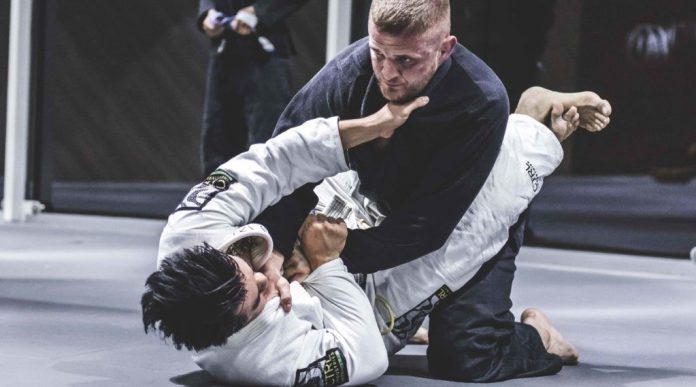
Brazilian Jiu-Jitsu is famous for many things. However, nothing gets close to the famous notoriety of the BJJ guard. In fact, not just one but all Jiu-Jitsu guards. let’s be honest, we all love playing guard. But which one? Today, there are more guards than you can count, let alone learn. One reason is that all the “old school” stuff never really went away as ens tuff poured in. On the contrary, the old school Jiu-Jitsu guards evolved and caught up in their own way. But how did it all come to be and why is the evolution of the BJJ guards so important?
Put simply, the guard game blew Jiu-jitsu up. the fact tath you can find Brazilian Jiu-Jitsu in every corner of the world nowadays is very much a result of the BJJ guard. When BJJ came along, nobody knew what fighting off the back was. Then, everyone wanted to learn it. As they did, people started having fun with the guard, mostly within the boundaries of Jiu-Jitsu as a sport. That gave birth to a whole host of Jiu-jitsu guards that then gave birth to even more. The cycle goes on and on. But guards are not just important for the bottom game. Think about it, the more guards there are, the more guard passes need to evolve to solve them.
The Story Jiu-Jitsu Guards
At first, when BJJ first appeared on the radar of martial arts, there was nothing more notorious than the closed guard. Other grappling arts already had chokes, armlocks, top control, etc. However, nobody had the option to fight off the back, let alone dominate from there. In Jiu-Jitsu, the closed guard was actually a neutral position. to an extent, it still is. The basic closed guard is a neutral position. If the top person retains posture and gets good grip, they have the advantage. If the bottom person controls the posture, they have an advantage. In that sense, the closed guard, and all of its variations, including the half guard, are in a category of their own.
Next up are open guards. They were not far behind the closed Jiu-Jitsu guards. As people caught on to the closed guard, they started opening it. So Instead of just fighting to reestablish it, people started grappling without it. That soon proved to be the correct direction, as opening your legs offered an incredible amount of options off the back. This is how the modern guard game of BJJ came about. moreover, this is how the entire game changed, because people now had many more positions to solve and think about, so everything took off at an unbelievable pace.
Finally, there’ the self-defense aspect. This is mostly why the basic closed guard and other “old-school” guards still work. As BJJ morphed into a full-blown sport, the techniques became sport-oriented. However, in MMA or a self-defense scenario, with different or no rules, not many things work. Precisely this gave the old staff a platform to develop and catch up, evolving in a direction of their own.
The Closed Guard
It all began with the closed guard. Whichever one of the Gracies ended up perfecting it (most likely Helio) they did a great job. The guard became the go-to position for the Gracies in all their challenges, and later, MMA matches. It was a position of relative safety, where you can deflect strikes, and keep your legs safe from leglocks. Moreover, it offered great attacking options, particularly with the Gi. Having the lapels, belts, and sleeves to hold on to really changed how people perceived fighting off the back.
However, the closed guard was just one position, and regardless of variations at the time, people were catching up. that means there are two avenues of progress – one is to keep doing it and let it fade to the background, like other martial arts moves. The other was to evolve and adapt it to the new circumstance. That’s exactly what happened and stuff like the high guard and overhook closed guard started developing.
The Half Guard
Speaking of the evolution of closed guards, probably nobody contributed more than Roberto Gordo Correa. Nursing a nasty injury to his knee, Gordo found out that it is hard to hold on to the closed guard like that. So, he decided to experiment and kept his injured leg on the bottom. Still, because open guards weren’t really around, Grodo found a way to close his legs. the result was the half guard, a position that revolutionized sports Jiu-Jitsu. Today, there are hundreds of half-guard varieties and hybrids, but they’re all down to that moment of innovation that spurred Gordo to give this new guard a try. In the evolution of Jiu-Jitsu guards, this is a hallmark moment.
Opening Up
After the half guard, or better said, as it developed, open guards started popping up. The reason for this was that people now figured out how to open the guard. After achieving that, getting past the legs was no big trouble. So, younger grapplers experimented, much to the disapproval of old-school traditionalists, made strides in the open guard territory. They started playing with a simple open guard, one leg hooking the knee and the other on the hip. From there came the famous De la Riva guard, and later on, the butterfly guard. Both their early open Jiu-Jitsu guards became the foundation for what was to follow.
What really defined the evolution of the open guards were tournaments. Competitors had to have more than just the closed guard and started making new stuff up. Some of it came from experimentation, others were the product of scrambles. Whatever the situation things like the butterfly guard, and the De la Riva became the next big things of BJJ and they’re still around.
Standing Opponents
Closely following the evolution of Jiu-Jitsu guards was the evolution of passes and counters. After opening the guard, those on top ran into the myriad of new open guards. That prompted people to do a logical thing, and start standing in order to find a safe way to solve the new puzzle. And it worked, for a while. As the cycle of Jiu-Jitsu guards goes, those on the bottom quickly found even more new ways to cause trouble to their opponents.
One big thing with people standing up was posture. So, trying to solve that particular puzzle, people started going fro grip heavy guards like the spider guard. To this day, the spider guard is one of the most effective guards in BJJ. Moreover, when grips weren’t available people started experimenting by getting tight on the legs. Hence, sitting guards and X guards were born. With all of this, BJJ just became more fun and much more complex. Now, the sports aspect of it is really booming because every guard causes a domino effect in terms of evolving ways to solve it.
Inverted Guard
Finally, we’re at a stage now that even more, mostly open Jiu-Jitsu guards got developed. At one point in time, someone found it useful to invert upside down in order to prevent a guard pass. From there on, the inverted guard and all its variations burst onto the scene. everything from the tornado guard to the Berimbolo is because of the inverted guard. Moreover, all kinds of new-school wacky guards followed, mostly those involving lapels, or crazy ways to control your body. In a strictly No-Gi sense, the rubber guard came along asking brand new questions of passers. The lapel grips changed the landscape of Jiu-Jitsu guards by introducing new grips to old guards, which eventually led to hybrid guards like the De la Spider guard etc.
During all this time, every guard variation kept evolving on its own, retaining much of the original position. That means that every new guard that comes around, never really goes away and that is what makes BJJ so complex and interesting. And the best part is that the evolution of Jiu-Jitsu guards is far from over In fact, it is just beginning.
In Summary
What’s next? There’s nothing left to ask apart from what comes next? I genuinely have absolutely no idea which guard is going to be the next big thing. It may be a new approach to the old school closed guard stuff, or it may be something completely new. Whatever it is, it si going to have a positive effect on Jiu-Jitsu as a whole. With every guard, passes, counters, re-guard preventions and a whole host of other areas get attention as well. Honestly, this is BJJ is so addictive – it is endless!


![Darce Choke Encyclopedia – Origins, Mechanics and Variations [2024] BJJ, choke, Brabo, BJJ Darce Choke, D'arce Choke, Darce BJJ Choke](https://bjj-world.com/wp-content/uploads/2017/11/JungPoirierLeeYahoo-218x150.jpg)









![Standing Leg Entries Alex West DVD Review [2025] Standing Leg Entries Alex West DVD Review](https://bjj-world.com/wp-content/uploads/2025/03/standing-leg-entries-alex-west-dvd-review-218x150.png)

![Best Marcelo Garcia Techniques by Team Marcelo Garcia DVD Review [2025] Best Marcelo Garcia Techniques by Team Marcelo Garcia DVD Review](https://bjj-world.com/wp-content/uploads/2025/02/best-marcelo-garcia-techniques-dvd-review-218x150.png)
![Forging The De La Riva Guard Giancarlo Bodoni DVD Review [2025]](https://bjj-world.com/wp-content/uploads/2025/02/de-la-riva-guard-giancarlo-bodoni-dvd-review-218x150.png)

![Breaking Their Guard Mikey Musumeci DVD Review [2025] Breaking Their Guard Mikey Musumeci DVD Review](https://bjj-world.com/wp-content/uploads/2025/02/breaking-their-guard-mikey-musumeci-dvd-review-218x150.png)
![Tiny Woman Guide To The Guard Ann Kneib DVD Review [2024] Tiny Woman Guide To The Guard Ann Kneib DVD Review](https://bjj-world.com/wp-content/uploads/2024/11/tiny-woman-guide-to-the-guard-ann-kneib-dvd-review-324x235.png)
![Finish on the Back Ethan Crelinsten DVD Review [2024] Finish on the Back Ethan Crelinsten DVD Review](https://bjj-world.com/wp-content/uploads/2024/10/finish-on-the-back-ethan-crelinsten-dvd-review-100x70.png)



![360 Degrees Guard Retention Thiago Abud DVD Review [2024] 360 Degrees Guard Retention Thiago Abud DVD Review](https://bjj-world.com/wp-content/uploads/2024/10/360-degrees-guard-retention-thiago-abud-dvd-review-100x70.png)

![Master Scissor Sweep Ryan Scialoia DVD Review [2025] Master Scissor Sweep Ryan Scialoia DVD Review](https://bjj-world.com/wp-content/uploads/2024/12/scissor-sweep-ryan-scialoia-dvd-review-100x70.png)
![Efficiently Executing X-Guard Giancarlo Bodoni DVD Review [2024] Efficiently Executing X-Guard Giancarlo Bodoni DVD Review](https://bjj-world.com/wp-content/uploads/2024/09/efficiently-executing-x-guard-giancarlo-bodoni-dvd-REVIEW-100x70.png)
![Double Sleeve Guard Jon Thomas BJJ DVD Review [2024] Double Sleeve Guard Jon Thomas BJJ DVD Review](https://bjj-world.com/wp-content/uploads/2024/10/double-sleeve-guard-jon-thomas-bjj-dvd-review-100x70.png)
![Henry Akins Black Hole No-Gi Closed Guard DVD Review [2024] Henry Akins Black Hole No-Gi Closed Guard DVD Review](https://bjj-world.com/wp-content/uploads/2024/09/henry-akins-black-hole-no-gi-closed-guard-dvd-review-100x70.png)
![Roger Gracie Closed Guard System DVD Review [2025] Roger Gracie Closed Guard System DVD Review](https://bjj-world.com/wp-content/uploads/2025/01/roger-gracie-closed-guard-system-dvd-review-100x70.png)
![Dubious De La Riva Dominique Bell DVD Review [2024] Dubious De La Riva Dominique Bell DVD Review](https://bjj-world.com/wp-content/uploads/2024/10/dubious-de-la-riva-dominique-bell-dvd-review-100x70.png)

![Flow Pressure Kauan Barboza DVD Review [2025] Flow Pressure Kauan Barboza DVD Review](https://bjj-world.com/wp-content/uploads/2025/02/flow-pressure-kauan-barboza-dvd-review-100x70.png)


![Underhooks With Uncle Jeff Glover DVD Review [2025] Underhooks With Uncle Jeff Glover DVD Review](https://bjj-world.com/wp-content/uploads/2025/02/underhooks-with-uncle-jeff-glover-dvd-review-100x70.png)

![Woj Lock the World Chris Wojcik Ankle Locks DVD Review [2024] Woj Lock the World Chris Wojcik Ankle Locks DVD Review](https://bjj-world.com/wp-content/uploads/2024/12/woj-lock-the-world-chris-wojcik-dvd-review-100x70.png)
![Leg Lock Strategies: Navigating Entanglements Jack Stapleton DVD Review [2024] Leg Lock Strategies: Navigating Entanglements Jack Stapleton DVD Review](https://bjj-world.com/wp-content/uploads/2024/12/navigating-entanglements-jack-stapleton-dvd-review-100x70.png)
![Higher Tripod Passing Craig Jones DVD Review [2025] Higher Tripod Passing Craig Jones DVD Review](https://bjj-world.com/wp-content/uploads/2025/02/higher-tripod-passing-craig-jones-dvd-review-100x70.png)
![Charles Allan Price Building Workouts For BJJ DVD Review [2024] Charles Allan Price Building Workouts For BJJ DVD Review](https://bjj-world.com/wp-content/uploads/2024/09/charles-allan-price-building-workouts-for-bjj-review-100x70.png)

![Two Sides One Game Sweep and Pass Marcos Tinoco DVD Review [2024] Two Sides One Game Sweep and Pass Marcos Tinoco DVD Review](https://bjj-world.com/wp-content/uploads/2024/11/sweep-and-pass-marcos-tinoco-dvd-review-100x70.png)

![Jeff Glover DVD Bundle Review: Chokin’ Around With Uncle Jeff [2024] Jeff Glover DVD Bundle Review: Chokin' Around With Uncle Jeff](https://bjj-world.com/wp-content/uploads/2024/10/jeff-glover-dvd-bundle-review-chokin-around-100x70.png)
![Wrestling For Jiu-Jitsu Shawn Williams DVD Review [2025] Wrestling For Jiu-Jitsu Shawn Williams DVD Review](https://bjj-world.com/wp-content/uploads/2025/01/wrestling-for-jiu-jitsu-shawn-williams-dvd-review-100x70.png)
![Gracie Secrets Closed Guard Kyra Gracie DVD Review [2024] Gracie Secrets Closed Guard Kyra Gracie DVD Review](https://bjj-world.com/wp-content/uploads/2024/12/closed-guard-kyra-gracie-dvd-review-100x70.png)